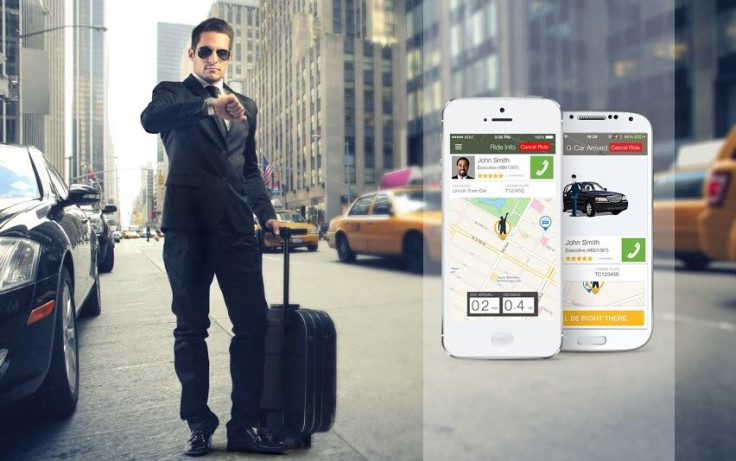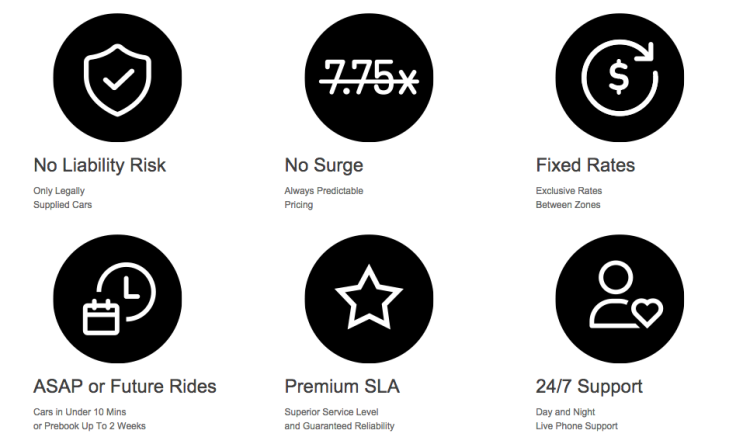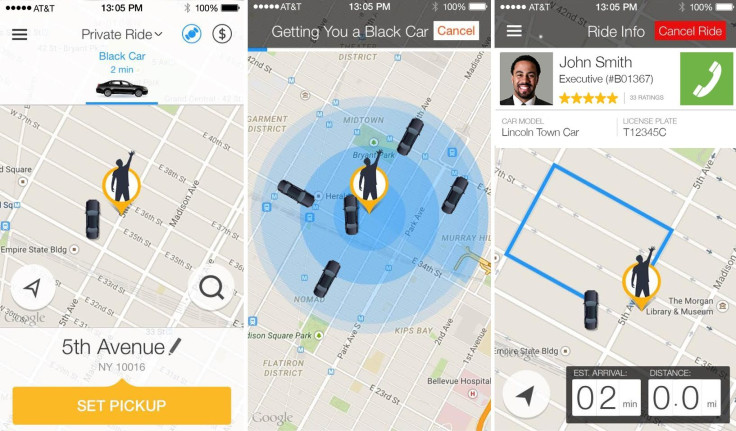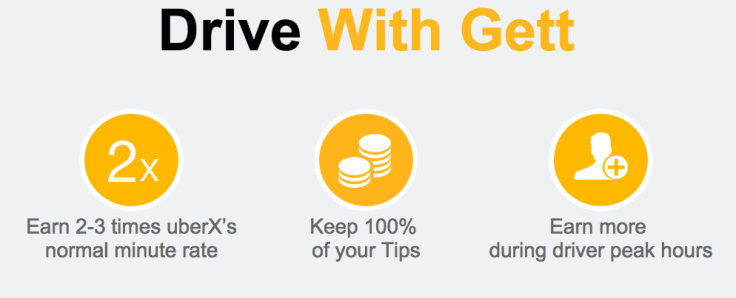What Is Gett? A Ride-Hailing Company Is Profitable Internationally, Makes A Half Billion In Revenue And Isn't Uber Or Lyft

While Uber Technologies Inc. has gained notoriety worldwide, the lesser-known Gett, formerly GetTaxi, was launched alongside it as another mobile-based taxi cab ordering service in 2009. Since then, the company has expanded to 50 cities -- 13 of which are in Israel. In 2011, Gett entered London. In 2012, Gett added Moscow as well as New York City.
There currently are 35,000 Gett drivers globally, 2,000 of them in New York. That pales before Uber's reported 160,000 drivers as of December 2014. But while Uber faces backlash in many cities it operates in -- whether by the government as we've seen in Paris or labor issues in California -- Gett says it is quietly winning over drivers and consumers by prioritizing contracts to provide car services to businesses.
International Business Times sat down with Gett's CEO and co-founder Shahar Waiser to learn about his company's strategies: what hurdles they've faced, how they're selling Gett to drivers and riders, why they're providing more on-demand services and what they think about Google's new ride-sharing service in Israel.
International Business Times: Tell me point blank. Is what you’re doing illegal?
Shahar Waiser: I think it’s actually ironic, right, that Uber in a way created an environment where they say — I think publicly — that in order to be disruptive you should be illegal. Gett is very unique in the way that it’s a very fast-growing enterprise. We’re doing this year half a billion in revenue, and we still grow 300 percent. It’s a really fast enterprise. At the same time, we are little. But we’ve proved that in every market we operate in we work with the legal type of supply — the professional type of supply.
We’ve never had legislation or legal claims in any country we’re operational in. Why it’s important? It’s important: A) Security of passengers and companies. B) Very important segment that Gett is famous for is B2B [business-to-business]. Many Fortune 500 names are our clients. The fact that we serve both those audiences is especially important that we have no liabilities.

IBTimes: So walk me through how your company works that makes it so it hasn’t been hit with the legal backlash that other companies have faced.
Waiser: Our model is very simple. Technology is supposed to work with any type of supply. It’s a matter of business decisions to whether or not you’re going to open this marketplace to someone who hasn’t passed medical or criminal checks and that have insurance, or you don’t. It’s up to you. Some businesses decide it’s much cheaper but more risky to work with anyone and never ever do a criminal check. We decided we cared about it.
There are some markets where we work with the taxis. There are some markets, like in New York, where we work with the black cars. As long as it’s legal, and [drivers] pass three basic things: medical, criminal checks and insurance. That’s it. It’s simple. I think some companies make it overcomplicated.
IBTimes: You provide technology. It seems that nowadays everyone can make an app. Why can’t other taxi companies just build their own and operate in that matter?
Waiser: The reality is different. In the world, there are very few players who can achieve significant scale. Tomorrow all of us can have an app. The fact we have an app doesn’t mean we have operations running. Volume in this case is important because you can create efficiencies. You can improve the efficiency up to the point that it’s almost an infinite ride, and you can pay the minimum cost. By that point, we can offer something that’s more competitive than others. The reality is that only a few can offer that. Having an app is not enough.
If you look around the world, there are two players. Outside of the U.S., the situation is a little bit different. There’s a local champion who owns 90 percent of the market, and there are others who provide their own services. Here, the local champion is Uber. But don’t be mistaken. Everywhere else, they’re less than 5 percent. It’s very much like the telecom space. You have Orange, O2, Vodafone. They’re very strong locally, great companies, billions of dollars, but they’re second in other markets. There are five big players now: Uber, clearly, then Gett as the largest internationally, and then actually Lyft and then there are players in India and China that are big in rides but not in revenues.

IBTimes: Bloomberg reported that Uber is operating at a $470 million loss. Tell me about how you’ve been able to achieve revenue.
Waiser: We didn’t have access to capital as much as Uber did at the beginning, and Lyft. So we actually built a very good financial discipline. I do believe that startups, in the early days, should have a financial discipline first and then have access to capital, because otherwise you have a wrong view of economics. We’ve been, since the early days, very mindful of growth and profits.
We’re profitable internationally. Everywhere outside of the U.S., we’re profitable. Now we’re investing this company in New York, offering amazing opportunities to consumers, practically being an Uber for $10, and having the B2B offering.
IBTimes: So here in the U.S. you’re operating at loss?
Waiser: When you launch operations you invest heavily to build supply and usability. To do that you subsidize. You give great offers and everything. Over time you need to make sure that you have revenue engines to generate profits. For us, it was always enterprise, the B2B. We can offer those amazing prices to consumers. We have this no-surge philosophy: 24/7, doesn’t matter the weather, time of day, you pay the same, no-surge, across the board. You put in a destination, and you know exactly how much it’ll cost you. It gives you peace of mind.
IBTimes: Guide me through the driver incentive. Let’s say I just lost my journalism job. I’m a licensed black cab driver. Convince me to join Gett versus Uber or Lyft or anything else out there.
Waiser: We pay better than Uber. If you’re an Uber driver your rates will be X. With Gett, it’ll be 2X. On top of that, you’ll get 100 percent of tips. We do tips through the app, and you get 100 percent. Not only you do per-minute twice as much, you also can get more at the end of the ride. Here, you have many drivers with Uber. It’s so easy to add another. Maybe not add five apps, but adding a second app is simple. What happens next is whenever Gett gives you an offer you always take Gett. None of us claim exclusivity.
Uber pays little to drivers because there’s no competition. Screw the supply and optimize on the demand. I’ll pay you less and less and less and take my surge-pricing up and up. Nothing to do with you [as the driver]. And I’ll take all the profit for myself.

IBTimes: What’s your marketing strategy here? I’ve seen consumer-facing ads on Facebook and Twitter, but are you reaching out to drivers? How are you getting them on board?
Waiser: There are three segments, and we are reaching them separately. Drivers is a very close community. They talk to each other a lot. One thing they really care about is really provide them value. I can put a big advertisement here, but it will not work if they know it doesn’t work. So create the value, create the pricing that really makes sense to them. So in no time you reach 2,000 and more. That’s what happened to Gett.
Another segment is the users. Most of the people right here [on Wall Street] are wealthy but not stupid. You can pay Uber rates, but if I can give you the same limo, professional driver, in five minutes, $10 across all of Manhattan, I feel better using this. We invest in this knowledge that people know they can have an alternative. It’s hard for me to see you, knowing that both operations, same car paying $10 or $30, I can guess what choice you will make. My hope for this year is that everyone in New York will know about this offering and this alternative.
And the companies. We have Salesforce. It’s really going company by company. Like Ernst & Young, Goldman Sachs.
IBTimes: I’m sure you’ve heard about the recent California ruling with an Uber driver winning a case to be classified as an employee and not a contract worker. Should Gett drivers be considered employees?
Waiser: My observation is very simple. The marketplace like Gett offers contractors an opportunity to get extra income at any time. The point is at any time. You choose when and what, and we give you the opportunity to make money whenever you want, not whenever I want.

Gett will continue to lead transportation but expand into other verticals, new lines of business. Especially, let’s talk about beauty services. There’s a lot of professionals there. You create a marketplace for millions of people, certified professionals in different segments. You can travel. You can work. You can take some time off. I think for the economy and for employment and for flexibility it’s just so good. Eventually I envision Gett as a platform for doing multiple services and products. So you can outsource housecleaning, manicures, but also if you have pets, you can ask someone to walk your pets. It’s open up the marketplace to everybody. That’s why we changed from GetTaxi to Gett.
IBTimes: Now we’ve seen these other companies like Google and Amazon launch on-demand delivery. How can you compete?
Waiser: Delivery is different. Delivery is like take that from there and give it there. The value of your delivery can be $2. You pay for delivery, like FedEx. There are many companies trying to do that. I am not there. What we’re trying to do historically is we’re responsible in bringing high-quality service in the below-benchmark price in a very efficient time. It’s not about take that pizza and bring it to me. It’s us being responsible in the whole chain. So we will not do everything. We will never offer you an endless amount of service and products, but those we will deliver will be critical.

IBTimes: We’re now seeing Google start its own ride-sharing, not specifically ride-hailing, company through Waze. Are you scared by that entrance?
Waiser: I think historically the competition in that space [ride-sharing] is phenomenal, from one hand. From the other, it’s a very market-by-market business. In every market where we operate we have a local champion, profitable, growing 300 percent, all that, so we feel comfortable. Competition usually and especially in our space motivates more people to use on-demand. What really surprised me is I don’t understand how people don’t use Gett. Usually 90 percent of people still don’t use on-demand. Like, what? How do they move? They still hail or call. The common goal is: How do you make 100 percent of people use it? I think once you have more companies promoting that it’s great.
Specifically with Google, they want to touch the area that is an inter-city kind of commute, and it’s an untapped area. There are a few companies that have been doing carpooling. Carpooling is different. Carpooling is very popular in Europe with BlaBlaCar. I think Google is exactly pointing there.
IBTimes: Self-driving cars is a hot topic from Uber and Google. Are you going to explore that?
Waiser: I think everyone’s been waiting for that patiently, and it’ll be great for technology and a revolution in the world, but the reality is that the technology is there. We met with auto car producers, and all of them have the technology available. The problem is not technology. It’ll take about 10 years for people to accept the fact of these cars driving on the street with their children.
At the same time, I can bet with you that after that, humans are going to be prohibited from driving because the amount of mistakes you will do will be higher. Yeah, I’m excited, but it’s not what we’re getting into. In this case, I can’t do anything about it. It’s not like the technology is missing. It’s super robust and available.
© Copyright IBTimes 2024. All rights reserved.












